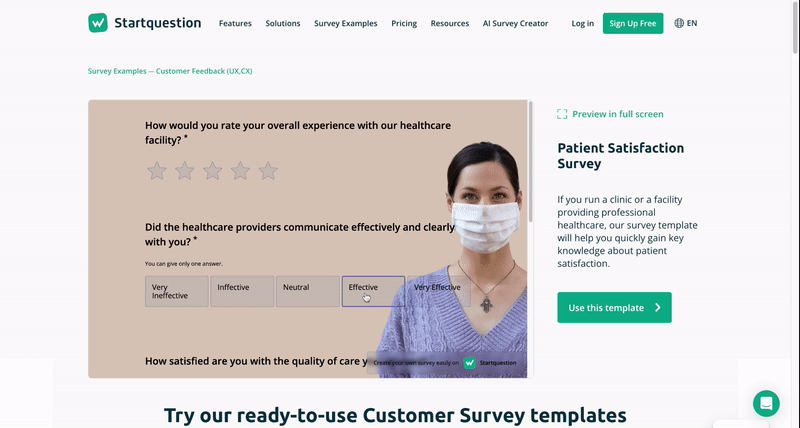Healthcare has prioritized a holistic patient experience rather than just medical services. The customer experience (CX) in healthcare encompasses all interactions between patients and their healthcare providers. Such an approach includes clinical aspects and the perception of care quality.
This article examines customer satisfaction in health system, including indicators of quality service, current trends, and methods for measuring healthcare customer experiences.
The Rise of Healthcare Customer Experience
Why is customer service important in healthcare? Over the past few years, healthcare system has undergone a significant digital transformation.
According to recent data from Cross River Therapy, the use of virtual care has increased 38-fold since the onset of the COVID-19 pandemic. As a result, telehealth services are expected to experience significant growth, with an estimated market value of $559.52 billion projected by early 2027.
In consequence, the healthcare industry has shifted from using the word “patients” to “customers,” reflecting a change in how healthcare is perceived and delivered.

Just click to try our ready-to-use Patient Satisfaction Survey
The consumerization of healthcare drives this shift, the rise of health insurance plans, digital transformation, patient-centered care, competition, market dynamics, expectations of convenience and quality, evolving payment models, and patient engagement and empowerment.
Healthcare consumers now expect the same level of comfort, transparency, and quality in healthcare as in other industries. Healthcare providers must differentiate themselves by providing a customer-centric experience that aligns with the competitive landscape.
Can You Measure CX in Healthcare?
Of course, and we are going to show you how to do it. Let’s start with brief theory.
The measurement of CX in healthcare is of utmost importance, as it offers healthcare providers the means to gather quantifiable data on patient experiences.
15 Benefits of Measuring Healthcare Consumer Experience
Measuring the healthcare consumer experience is crucial for delivering high-quality, patient-centered care and staying competitive in the healthcare industry. It benefits both healthcare organizations and the individuals they serve.
- Improved Patient Satisfaction:
Understanding patient experiences helps identify areas for improvement, leading to higher patient satisfaction and better overall care.
- Enhanced Quality of Care:
Consumer feedback can highlight deficiencies in healthcare delivery, enabling providers to make necessary improvements in care quality.
- Better Patient Engagement:
Monitoring patient experiences promotes engagement, encouraging patients to take an active role in their health and healthcare decisions.
- Increased Loyalty and Retention:
Satisfied patients are more likely to remain loyal to a healthcare provider or organization, reducing patient turnover.
- Enhanced Reputation:
Positive patient experiences can boost an organization’s reputation, attracting new patients and referrals.
- Targeted Improvement Efforts:
Data on consumer experience can pinpoint specific areas or processes that require attention, allowing for targeted improvements.
- Compliance with Regulations:
In some healthcare systems, measuring and reporting consumer experience is a regulatory requirement, ensuring adherence to industry standards.
- Efficiency Gains:
Streamlining processes based on patient feedback can lead to operational efficiencies and cost savings.
- Risk Mitigation:
Identifying and addressing patient concerns early can reduce the risk of medical malpractice claims or other legal issues.
- Research and Innovation:
Consumer experience data can serve as a valuable resource for healthcare research, innovation, and the development of new services or treatments.
- Data-Driven Decision Making:
It provides valuable insights that enable healthcare leaders to make informed decisions about resource allocation and strategic planning.
- Patient-Centered Care:
Focusing on positive customer experience reinforces the shift towards patient-centered care, where the patient’s needs and preferences are at the forefront of healthcare delivery.
- Reduced Health Disparities:
Measuring experience across diverse patient populations can help identify and address disparities in care, promoting health equity.
- Benchmarking and Comparison:
Healthcare organizations can compare their performance to industry benchmarks and competitors, driving continuous improvement.
- Financial Benefits:
Improved patient satisfaction and loyalty can have a positive impact on the financial health of healthcare providers, leading to increased revenue and reduced costs associated with patient turnover.
Patient Satisfaction Survey
If you run a clinic or a facility providing professional healthcare, our survey template will help you quickly gain key knowledge about patient satisfaction.
Patient Satisfaction Survey
If you run a clinic or a facility providing professional healthcare, our survey template will help you quickly gain key knowledge about patient satisfaction.
What Patients Consider a Good Healthcare Services?
Understanding what patients value in healthcare services is pivotal in enhancing CX. Patients consider several factors when assessing the quality of healthcare professionals, including:
Limited Wait Times
Patients highly value their time, and long wait times can lead to frustration and negatively impact their perception of quality care. Implementing efficient appointment scheduling and reducing wait times can significantly improve patient experience.
For example, a primary care clinic that utilizes an online appointment booking system and minimizes in-office wait times will likely receive positive feedback from patients who appreciate the time saved.
Personalized Care
Providing healthcare services tailored to individual needs and preferences is crucial, as every patient is unique. Healthcare providers who take the time to understand their patients’ requirements tend to receive higher patient satisfaction scores.
For instance, a doctor who remembers a patient’s name, medical history, and personal preferences creates a sense of trust and personalized care.
Sensitive Data Security
In today’s world, patients expect healthcare providers to handle their personal and medical information with the utmost care and security. Implementing robust data protection measures to build trust and enhance the overall patient experience is crucial.
Any patient data breach can negatively impact the healthcare provider’s reputation and erode the patient’s confidence in the institution. Thus, ensuring robust data protection measures, including compliance with cloud security standards, is essential for maintaining patients’ trust and confidence in healthcare providers.
In addition, patients value healthcare facilities with clear policies regarding storing and sharing their data. For instance, when a healthcare facility communicates its data protection measures and allows patients to choose whether to share their data for research purposes, it shows that it respects patient autonomy and improves the overall patient experience.
Current Customer Experience Trends in Healthcare
Much like any other industry, the healthcare sector is ever-changing and advancing. As a result, the trends in CX are also constantly evolving. To stay up-to-date with the latest developments, knowing the emerging trends shaping the landscape is essential for any healthcare provider.
Chatbots in Healthcare
Chatbots are computer programs that simulate human conversation. In healthcare, they are used for various purposes:
- Patient Engagement: Chatbots can interact with patients to provide information, appointment scheduling, and medication reminders.
- Symptom Assessment: They help users assess their symptoms and provide preliminary advice or direct them to appropriate medical services.
- Health Education: Chatbots can offer information on various health topics, helping users make informed decisions.
- Mental Health Support: Some chatbots are designed to provide emotional support and mental health counseling.
Telehealth Platforms
Telehealth platforms are comprehensive systems that enable remote healthcare services, consultations, and information exchange between patients and healthcare providers. They often include:
- Video Conferencing: Patients can have real-time video consultations with healthcare professionals, enhancing access to care.
- Secure Messaging: Communication between healthcare customers and providers through secure messaging for non-emergency inquiries.
- Electronic Health Records (EHR) Integration: Telehealth platforms can integrate with EHR systems, ensuring seamless data sharing.
- Remote Monitoring: Some platforms allow remote monitoring of patients’ vital signs and health metrics.
Telemedicine
Telemedicine refers to the practice of providing medical care remotely through technology. It encompasses various services and technologies:
- Remote Consultations: Patients can consult with healthcare professionals, including doctors and specialists, via video or phone calls.
- Store-and-Forward: This involves sending medical information (e.g., images, test results) to specialists for review and diagnosis.
- Home Health Monitoring: Devices such as wearables or connected sensors help monitor patients’ health at home and transmit data to healthcare providers.
- E-Prescriptions: Doctors can electronically prescribe medications, improving convenience for patients.
- Tele-ICU: In intensive care units, telemedicine is used to remotely monitor patients’ conditions and provide critical care expertise.
Since 2021, these technologies have continued to advance rapidly, especially in response to the COVID-19 pandemic, which accelerated the adoption of telehealth and telemedicine. New developments may include enhanced AI-powered chatbots, improved video conferencing tools, increased integration with wearable devices, and expanded telemedicine services.
Try Other CX Survey Templates
How to Measure Patient Experience?
Assessing patient experience is a multifaceted and critical process that requires practical tools for gathering insights. The patient satisfaction survey is a highly beneficial approach among the available tools.
Compared to traditional paper surveys, patient satisfaction surveys are much better in obtaining accurate and reliable data. As such, it is a recommended tool for healthcare providers seeking to improve their service delivery and enhance the overall patient experience.
Benefits of Using Patient Satisfaction Surveys
Patient feedback is a powerful tool that can help healthcare providers improve their quality of care. Satisfaction surveys provide a structured way to collect feedback on various aspects of healthcare services, tailored to assess specific areas of interest.
By keeping patient feedback anonymous and confidential, healthcare providers can encourage honest responses that help identify trends and areas for improvement.
This data-driven approach to benchmark performance over time and against industry standards inspires healthcare providers to prioritize training and development initiatives in communication, wait times, and treatment effectiveness.
The feedback collected through surveys provides actionable data that can be used to implement targeted quality improvement initiatives, enhancing the patient-centered approach to healthcare.
By allocating resources to address identified issues and monitoring improvements over time, healthcare providers can continue to inspire positive change and provide the highest quality care possible.
Survey Questions to Ask For Healthcare Organization
Overall Satisfaction:
- How satisfied are you with the care you received during your visit?
This question provides a broad measure of the patient’s overall satisfaction, which is a critical indicator.
Communication:
- Did your healthcare provider communicate clearly and effectively with you?
Effective communication is essential for understanding diagnosis and treatment plans.
Courtesy of Staff:
- How would you rate the courtesy and friendliness of the healthcare staff, including receptionists and nurses?
The demeanor of healthcare staff significantly impacts the patient experience.
Recommendation:
- Would you recommend our healthcare facility to a friend or family member?
A patient’s willingness to recommend a healthcare provider reflects their overall satisfaction and confidence in the quality of care.
Cleanliness and Comfort:
- How would you rate the cleanliness and comfort of our facilities?
A clean and comfortable environment is crucial for patient comfort and safety.
The questions cover essential aspects of the patient experience, such as satisfaction levels, communication effectiveness, staff courtesy, probability of recommendation, and the physical environment of the healthcare facility.
They offer a brief but comprehensive evaluation of the patient’s viewpoint and can be used by health care providers as valuable indicators for improving the quality of services.
CX in Healthcare – Sum Up:
Customer experience is of principal importance in the healthcare industry.
It encompasses all interactions between patients and healthcare providers beyond clinical treatment. To deliver exceptional healthcare experiences, it is crucial to understand what patients value, stay up-to-date with current CX trends, and use practical measurement tools such as patient satisfaction surveys.
As healthcare evolves, prioritizing and continuously improving customer experience will set leaders apart, benefiting patients and healthcare organizations. Improving CX in healthcare is a continuous journey, but it is worth undertaking for the improvement of patients and the healthcare system.
Try Software Tool For Patient Satisfaction Surveys
Are you ready to improve healthcare customer experience and retain patients?








